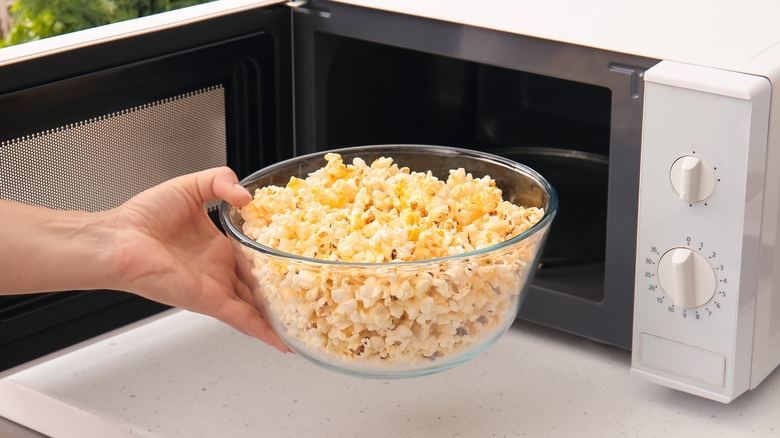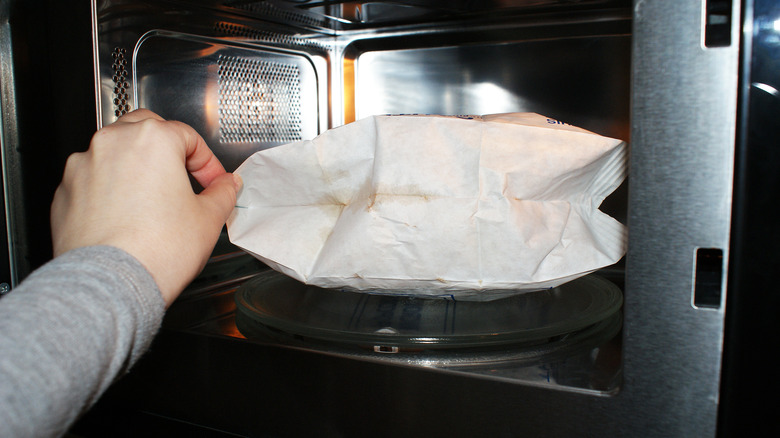Is There Really A Right Side For Microwaving Bagged Popcorn?
Have you ever noticed the "THIS SIDE UP" label on bags of microwave popcorn? The bag doesn't look different from either side, as you might have already realized — why do you need to make sure one particular side faces upward? Do you follow Orville Redenbacher's rule to the letter and keep the requested side upward, or do you just toss the bag in on either side, press the right buttons, and hope for the best? Does it really affect the outcome? Is this an actual rule, or a mere suggestion?
As it turns out, it doesn't really matter which side you microwave your popcorn on, as you might have already discovered if you're a rule-breaker: Either way, you'll end up with a piping hot bag of freshly-popped corn. But if that's the case, why do popcorn manufacturers tell you that there's a "right side" and a "wrong side" to that bag of movie theater butter-flavored popcorn you have in your cabinet? The answer is more complex than you might expect.
You can microwave popcorn on either side
Microwaving your popcorn on the "wrong side" does not result in the bag exploding, deflating, or destroying your microwave like a time bomb of butter and kernels. In fact, pretty much nothing at all will happen if you put the bag on the wrong side. If microwaving your popcorn with the wrong side down doesn't result in a terrible outcome, why even have the warning there in the first place?
While there is no major disaster awaiting those who disobey their popcorn bag's rule, there is a distinct — if slight — effect. You won't notice it in the course of everyday popcorn-making, but if you were to pop a dozen bags and carefully note how many kernels successfully popped and how long it took them to do so, you might notice a few minute differences. Bags microwaved on the wrong side take a little bit longer to pop their kernels, for one thing. There are also marginally fewer kernels popped.
You couldn't really call either of these differences noticeable. Moreover, the popcorn's taste — the most important factor in play, here — is unaffected. But why do these differences exist at all? The answer lies within the design of the bag itself.
Each bag of popcorn has a susceptor in it
If you look inside an empty popcorn bag, you'll notice what looks like a large rectangular shape. If you were to tear the bag apart, you'd find that this rectangle is made up of a different type of material than the rest of the bag. This is a susceptor, and it helps make the popcorn kernels pop.
A susceptor is a type of material that can be found in many types of microwavable packages. They're in Hot Pocket sleeves, microwavable French fry packaging, and, of course, popcorn bags. The susceptor draws in heat from the microwave and directs it into the cooking vessel, which cooks the food inside of the package. Put more simply, it transfers heat from the exterior to the interior of the bag. This pops the corn.
But what does this have to do with the "THIS SIDE UP" message on the bag of popcorn? When the bottom side of the bag faces down, as the directions state, the susceptor is closer to the heat, and can more efficiently direct it into the bottom of the bag. When the susceptor is on top, it can still heat the bag, but it can't pop as many kernels. Thus, small differences emerge. It's not a major change, but if you want to get the absolute most out of your popcorn, it's worth paying attention to which side is up.


